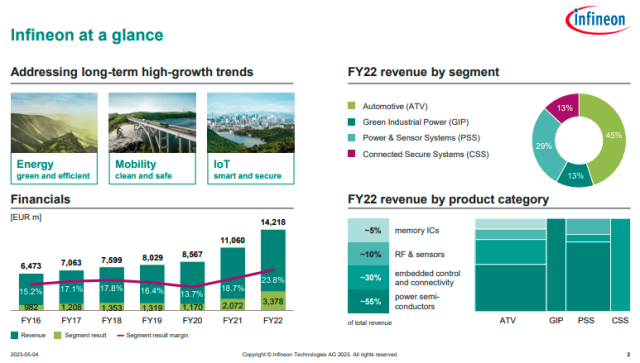Infineon Technologies reported 4 percent increase in revenue to €4.119 billion with gross margin of 46.6 percent for the second quarter of its 2023 fiscal year ended 31 March 2023.

Chipmaker Infineon has revised the revenue forecast for the 2023 to €16.2 billion (plus or minus €300 million) from €15.5 billion (plus or minus €500 million). This is equivalent to a growth rate of 14 percent compared with the 2022 fiscal year.
“Though an improvement in consumer goods markets such as smartphones, PCs and home appliances is not visible, we are nevertheless very confident overall about Infineon’s future business performance,” Jochen Hanebeck, CEO of Infineon, said in its earnings report.
Infineon business in Jan-March
Infineon’s Automotive (ATV) revenue rose 11 percent to €2,080 million, compared with €1,872 million in the first quarter of the current fiscal year mainly due to demand in the areas ADAS and electric vehicles.
Infineon’s Green Industrial Power (GIP) segment revenue rose 12 percent to €558 million, from €500 million in the prior quarter due to increasing demand in all application areas. Particularly dynamic revenue growth was to be seen in the areas of renewable energy, energy infrastructure, automation and industrial drives, as well as transport.
Infineon’s Power & Sensor Systems (PSS) segment revenue fell 11 percent to €925 million from €1,043 million in the prior quarter due to a reduction in the revenue derived from a variety of applications, especially those in the consumer area. Demand for charging stations for electric vehicles and onboard chargers continued to be positive.
Infineon’s Connected Secure Systems (CSS) segment revenue rose 4 percent to €550 million from €531 million in the first quarter of the fiscal year thanks to growth in payment cards, microcontrollers, government identification and embedded SIMs.
Infineon is planning Capex of around €3 billion for the 2023 fiscal year. The focus of the Capex will be on the construction of the third manufacturing module on the Kulim site (Malaysia) to produce compound semiconductors, the start of construction work on the fourth manufacturing module in Dresden (Germany) to produce analog/mixed-signal components and power semiconductors, and the expansion of frontend manufacturing capacity especially in Dresden (Germany) and Villach (Austria).
